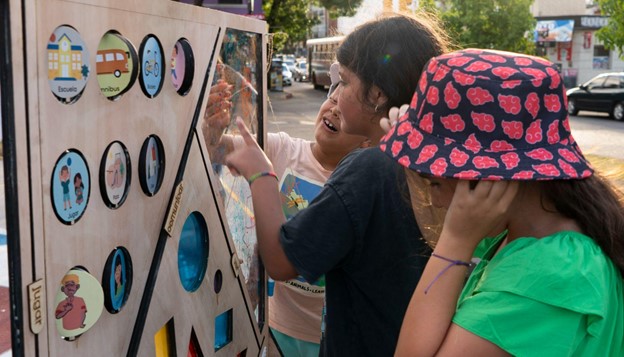
Descripción general
Localización:
Montevideo, Uruguay
Organisation:
Espacio Ludico
Partner organisations:
School 197; Montevideo LAB
Año:
2022
Escala de proximidad:
Vecindario
Beneficiarios destinatarios:
Niños de 0 a 5 años; cuidadores; comunidad sorda.
Defender nuevos enfoques para un diseño urbano integrador
Las ciudades están llenas de oportunidades para aprender, jugar y encontrar comunidad. Pero no todo el mundo tiene acceso a estas oportunidades a menos que hagamos que los espacios públicos sean inclusivos. Eso es lo que pretende nuestro proyecto, Sensing City. Defiende y propone espacios públicos donde los niños sordos y sus cuidadores se sientan incluidos.
Nuestro principal objetivo es apoyar a los niños, en particular a los sordos, de la Escuela nº 197 de Montevideo, que cuenta con unos 100 alumnos de 5 a 12 años. Una calle cercana que da acceso a la escuela está actualmente dominada por los coches, con estrechos caminos peatonales, lo que dificulta que los alumnos de la escuela visiten la plaza o utilicen el barrio como espacio educativo. No sienten que este barrio y la ciudad estén pensados para ellos, y rara vez pasan tiempo en los espacios públicos abiertos. Este proyecto también apoya a los cuidadores, haciendo que la experiencia urbana sea más acogedora, con lugares de descanso y elementos de juego diseñados para fomentar la relación niño-cuidador y su comunicación.
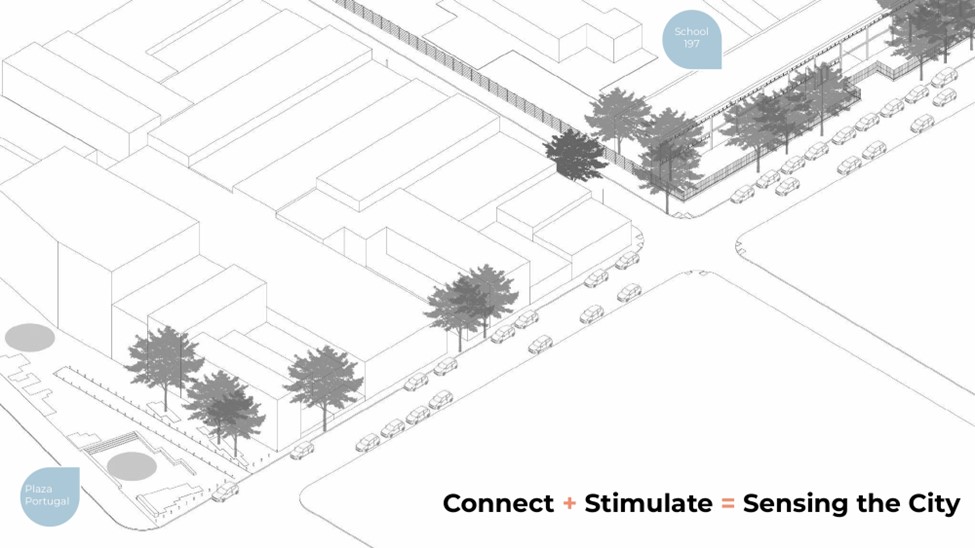
Se identificó una calle dominada por coches que impedía el acceso seguro de los escolares a la plaza pública local, impidiendo su uso potencial como espacio lúdico o educativo.
Comprender las necesidades de la comunidad sorda
Nuestro enfoque de diseño se centra en la integración: ¿cómo podemos utilizar el diseño para facilitar una comunicación inclusiva que acerque a los sordos y a la comunidad en general? Para ello, nuestro primer paso en el enfoque de Proximity of Care fue comprender a la comunidad sorda, sus necesidades y aspiraciones, y situarlas en el contexto uruguayo. La bibliografía existente y la práctica del diseño urbano son limitadas y se centran principalmente en las discapacidades en general, sin una visión específica de las necesidades de las personas sordas y, menos aún, en las barreras de comunicación a las que se enfrentan los niños sordos.
Para afrontar este reto, celebramos varias sesiones con la comunidad local para comprender mejor cómo nuestro proyecto puede apoyar las necesidades de los niños sordos y sus cuidadores. Desarrollar actividades de diseño para niños sordos nos animó a pensar en formas lúdicas de implicarlos en el proceso de diseño, y nos enseñó mucho sobre la importancia del entorno físico para facilitar el lenguaje de signos y las formas de comunicación cuando hablar y escuchar no es una opción. Fue una oportunidad única para hacer crecer nuestra práctica del diseño participativo en una dirección desconocida y urgentemente necesaria.
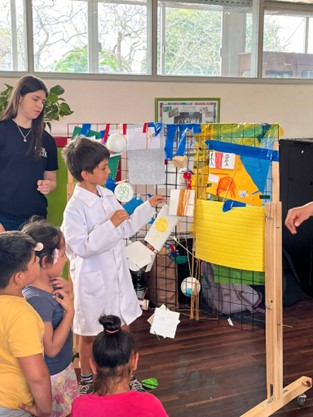
Se diseñaron talleres para niños sordos en los que se utilizaron materiales lúdicos y visuales para que pudieran comunicar sus aspiraciones y necesidades.
Diseño inclusivo para niños pequeños, la comunidad sorda y grupos más amplios.
Los principios y el planteamiento de Proximity of Care nos ayudaron a identificar oportunidades en las que nuestro proyecto podría apoyar mejor al barrio y a su comunidad sorda. La guía nos ayudó a estructurar la evaluación de la zona en función de distintos objetivos y a descubrir oportunidades de intervención en el diseño a través de las relaciones entre ellos. Por ejemplo, nos dimos cuenta de que los niños sordos sólo se sienten seguros, protegidos y estimulados en sus casas o en la escuela especializada con la que trabajamos. Utilizando los principios de Proximity of Care y centrándonos en las necesidades específicas de este grupo de niños, desarrollamos un proyecto de diseño que aumentaría la integración de la comunidad sorda en la red de lugares que conectan estos dos lugares: la escuela y sus hogares. Así pues, nuestro proyecto se centró en la reurbanización del paisaje urbano y la plaza pública en las proximidades de la Escuela nº 197.
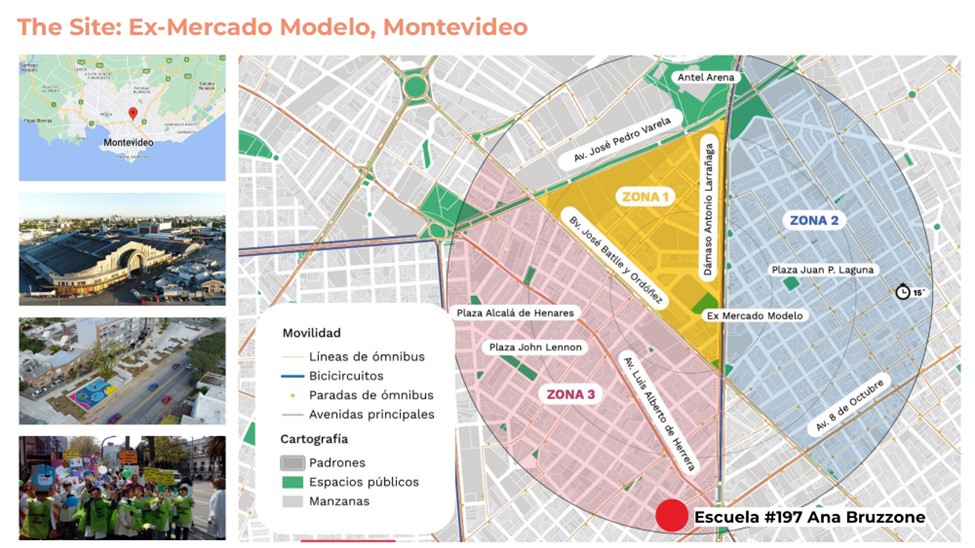
Se llevó a cabo una evaluación no sólo del lugar de la intervención, sino también del barrio y de la ciudad en general para comprender cómo podían conectarse los objetivos de la intervención a múltiples escalas.
Con la guía Proximity of Care nos dimos cuenta de la importancia de centrarnos en la primera infancia a la hora de diseñar nuestras ciudades, y de cómo los entornos seguros y estimulantes favorecen el desarrollo infantil. Este enfoque en la primera infancia y en las relaciones de los niños con sus cuidadores reforzó nuestro proyecto, ya que descubrimos que, en la mayoría de los casos uruguayos, muchos niños sordos sufren barreras de comunicación que afectan a su desarrollo.
También hay elementos del proyecto que benefician a toda la comunidad, como las transformaciones espaciales del tráfico; se reducirá la velocidad de los coches, los pasos de peatones serán más cortos y las aceras más anchas, lo que permitirá la comunicación por lenguaje de signos. También estamos desarrollando un camino estimulante y educativo, creando un paseo atractivo para todas las edades y fomentando el uso de los distintos sentidos y del cuerpo para explorar nuestra ciudad;
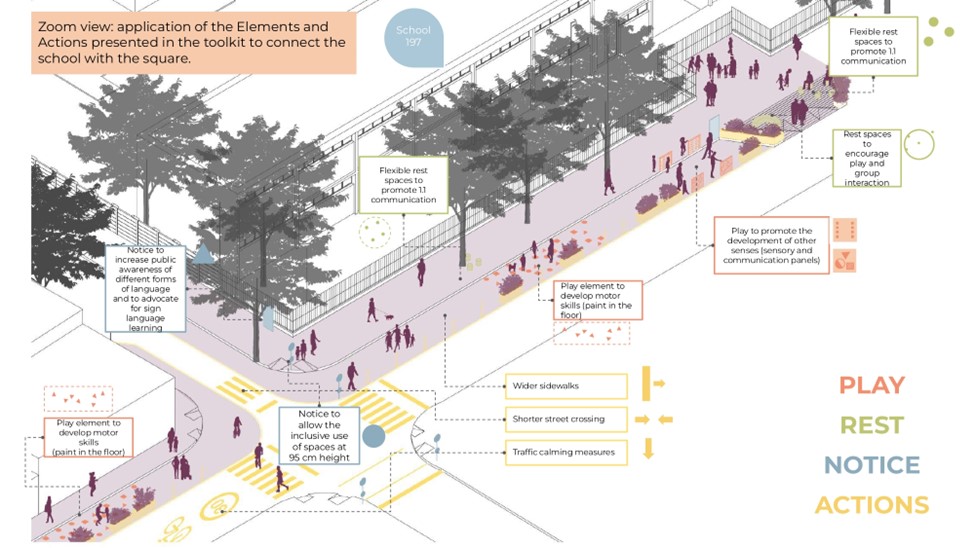
El diseño conceptual tiene en cuenta las necesidades de los niños sordos incorporando aceras laterales más anchas y asientos inclusivos para facilitar la comunicación, además de incluir elementos para uso y disfrute de la comunidad en general.
Influir en el cambio de comportamiento a través del diseño urbano
El enfoque de Proximity of Care nos hizo más conscientes de la influencia del proyecto; definiendo los personajes de nuestra audiencia, diseñando los mensajes centrales que queremos comunicarles y aprendiendo estrategias para mejorar la forma en que promovemos nuestro proyecto e involucramos a nuestra audiencia para que se conviertan en defensores de un cambio positivo. Como parte de nuestra intervención, invitamos a creativos y profesionales urbanos de Montevideo a participar en el concurso de diseño de un cartel para promover la integración de la comunidad sorda en los espacios públicos de Uruguay. Esta actividad despertó el interés de la comunidad local por este tema, reuniendo a expertos en diseño y planificación urbana, desarrollo de la primera infancia, lengua de signos, así como a profesores, alumnos y cuidadores de la Escuela nº 197.
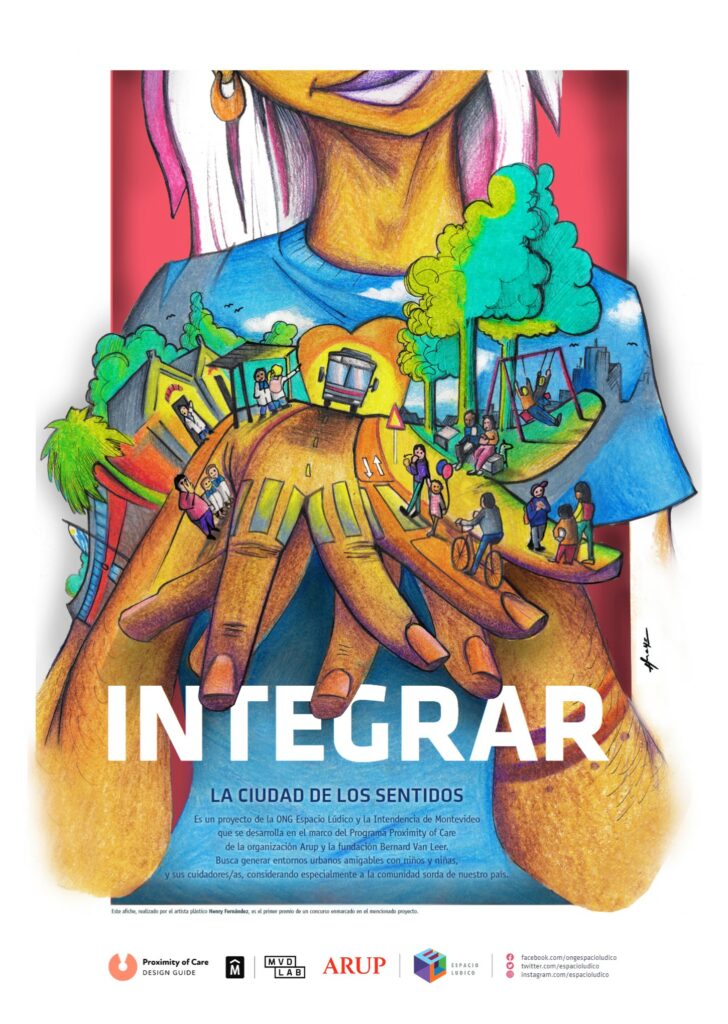
The winning poster from a design competition on representing the concept of integration represents the city as a woman signing the gesture for “integration” in sign language, illustrated to include the coming together of schools, public squares and everyday situations, with people sensing the city in different ways.
Once we learned the importance of how to better communicate the project and the right audiences to target, we had a better understanding of the internal resources needed to design the core messages, the communications strategy and the time needed to measure the impact of our design and advocacy plan.
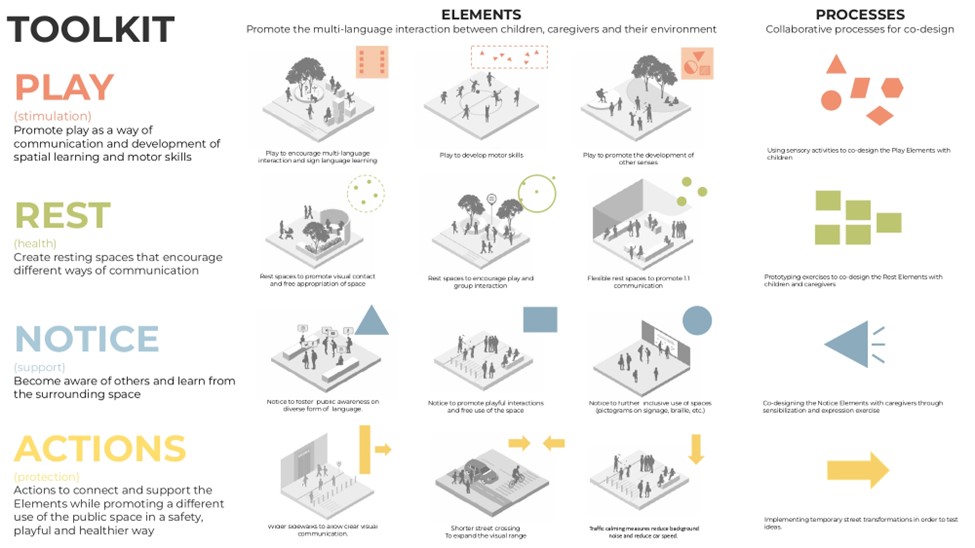
A toolkit of design elements which promote multi-language interaction between children caregivers and their environment is planned for the next stage of the project, developed to be used by other organisations and local municipalities across Uruguay.
The Proximity of Care guide also helped us to think beyond the design itself and to focus on behavioral change and processes. Design is only one component of the process that has the power to achieve true transformation of the urban realm. Understanding that our project, even though located in the public space, could have an impact and change behaviours of children and caregivers at the household level was a big revelation. The next task was to identify ways of working towards this goal. For example, our project is implementing elements that support inclusive communication in the public space, with the intention of fostering better interaction and understanding between children and their caregivers generally. By bringing these design changes in the street and square surrounding School No. 197, our project will significantly increase the city area in which deaf community feels safe, comfortable and playful.
In January 2023, we ran a set of workshops and tested two prototypes for improving the child-caregiver interaction in the Plaza Portugal. The interactive panel, co-designed with children from School #197 was a way to test an urban element that would stimulate play and interaction between deaf children, their caregivers and others. It was comprised of several sections, each testing a different way of communication: (1) moveable parts that teach sign language for neighbourhood-related words, (2) vibration, (3) touch and texture, (4) puzzles about the public space, (5) transparent panel for drawing and looking, (6) secret storage for smells. The second prototype was a mock-up bench that was designed with the needs of deaf children in mind. Circular shape enabled sign language communication (through looking at each other), while the space below the seating offers an exploration polygon for babies and toddlers. These prototypes were tested by the school children, neighbours and local visitors. We followed and documented the process through structured video observations, surveys and interviews, together with the participatory department from the local municipality – Montevideo LAB.
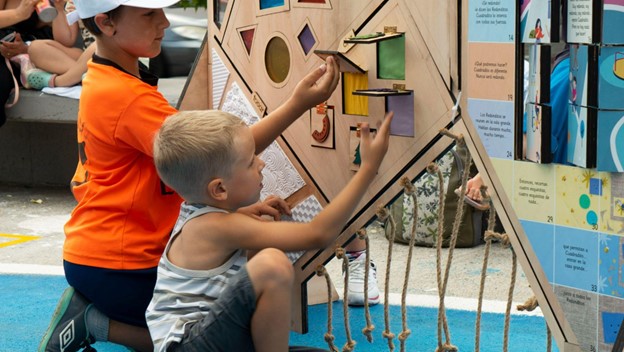
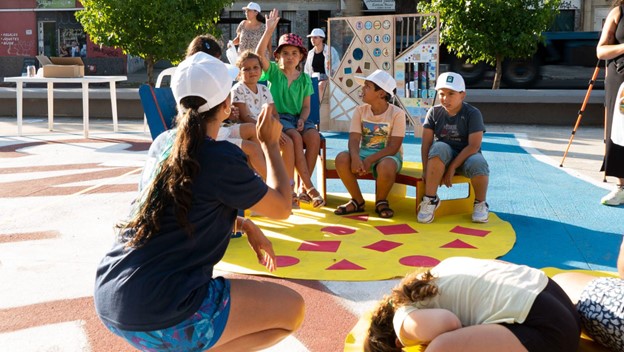
Sensing the City Pilot Project: After meeting with neighbours and co-designing urban furniture with deaf children, Espacio Ludico tested the project ideas and prototypes with the local community. Top: interactive panel; bottom: circular bench.
On the day, we also tested a few traffic regulation options with the local community and municipality, and held a panel about communication through different senses in the city. Throughout the day, there were people distributed around tables and chairs, that constantly translated between words and signs, and made everyone feel heard and included. It was a weekend full of emotions and ideas, where people in Montevideo had a chance to experience what it means to really understand and empathise with the experiences of others, and different ways of being in the city. It takes a lot of imagination to be able to understand what it means to walk in someone else’s shoes, but this is an essential prerequisite for building an inclusive city.
For the first time, we felt we are getting to understand what an inclusive city is, beyond ideas and labels.
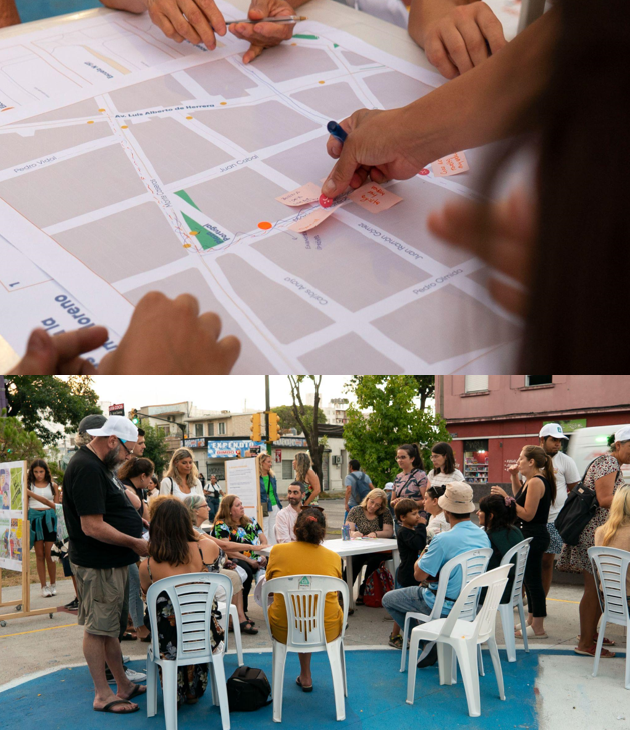
Top: Testing the traffic options with neighbours; Middle: simultaneous translation from and to the sign language; Bottom: workshop about experiencing the city through different senses.
Defining success for inclusivity in the ‘Sensing the City’ project
In order to define our project as successful, we’re aiming to:
(1) Improve interaction between deaf children and their caregivers in public space, as well as the integration among deaf and non-deaf children.
(2) Create public space opportunities for motor, sensorial and social development of deaf children from 0 to 5.
(3) Encourage the use of the Plaza Portugal and the public space surrounding School 197 as a space for learning.
(4) Increase the use of the public space in front of School 197 and the Plaza Portugal by children from 0 to 5 and their caregivers.
(5) Make the wider community aware of the importance of a secure, healthy, and stimulating public environment for children’s development, particularly for deaf children from 0 to 5 years old.
(6) Intensively collaborate with the Montevideo LAB (participatory department of the City Council) in strengthening their inclusive design approaches.
(7) Redesign the streetscape in collaboration with the City Council, to make it more safe and accessible to deaf children.
(8) Contribute to the knowledge and urban design practice for deaf community.
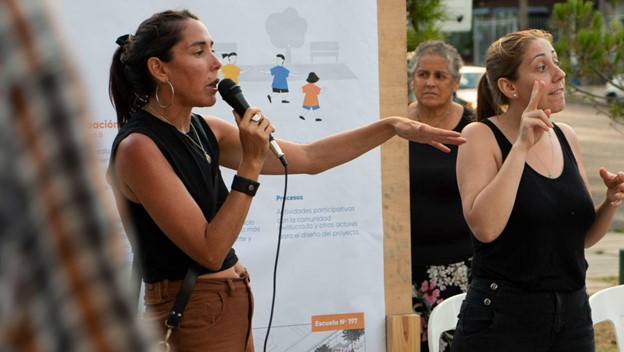
The inclusive concept design is promoted at the pilot event to receive feedback from the wider community, facilitated by a sign-language interpreter.
Four lessons from the Proximity of Care Guide that can be applied to any design project
The Proximity of Care guide served as an excellent tool to understand the area, and to learn from its challenges and opportunities in order to propose better design solutions. It supported us in strengthening how we communicate about the project, not only with deaf children and caregivers who were part of the whole process, but also with the wider community, decision makers and advocates. In this sense, the guide could easily be applied to other projects in our city and its lessons and principles should accompany all our projects.
We’ve learnt some important lessons along the way, that could be applied to any design project aiming to support local communities:
(1) Firstly, start the process by analysing and understanding the Proximity of Care dimensions and goals.
(2) Take the time to prioritise the different factors relevant to your urban context, time, and resources available.
(3) With a preliminary analysis and site visit, do transect walks to better understand your audience and discover opportunities for audience engagement.
(4) Lastly, define the methods you will use to approach the site and identify the challenges and opportunities according to the behaviour change principles.
Links and sources
